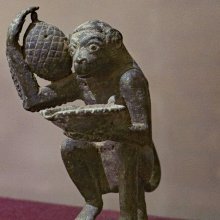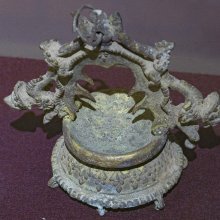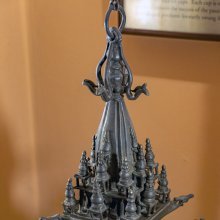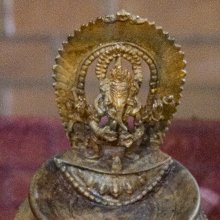Talu, Tālu, Ṭālu, Taḻu, Ṭhālu: 24 definitions
Introduction:
Talu means something in Hinduism, Sanskrit, Buddhism, Pali, Marathi, Jainism, Prakrit, Hindi, Tamil. If you want to know the exact meaning, history, etymology or English translation of this term then check out the descriptions on this page. Add your comment or reference to a book if you want to contribute to this summary article.
Images (photo gallery)
In Hinduism
Vyakarana (Sanskrit grammar)
Source: Wikisource: A dictionary of Sanskrit grammarTālu (तालु).—Palate; cf. तालुशब्देन जिह्वाया अधस्तन-प्रदेश उच्यते । स इवर्णस्य स्थानम् । जिह्वामध्यं करणम् । (tāluśabdena jihvāyā adhastana-pradeśa ucyate | sa ivarṇasya sthānam | jihvāmadhyaṃ karaṇam |) cf. T. Pr. II. 22.

Vyakarana (व्याकरण, vyākaraṇa) refers to Sanskrit grammar and represents one of the six additional sciences (vedanga) to be studied along with the Vedas. Vyakarana concerns itself with the rules of Sanskrit grammar and linguistic analysis in order to establish the correct context of words and sentences.
Shaivism (Shaiva philosophy)
Source: academia.edu: The Śaiva Yogas and Their Relation to Other Systems of YogaTālu (तालु, “palate”) refers to one of the sixteen types of “locus” or “support” (ādhāra) according to the Netratantra. These ādhāras are called so because they “support” or “localise” the self and are commonly identified as places where breath may be retained. They are taught in two different setups: according to the tantraprakriyā and according to the kulaprakriyā. Tālu belongs to the latter system.

Shaiva (शैव, śaiva) or Shaivism (śaivism) represents a tradition of Hinduism worshiping Shiva as the supreme being. Closely related to Shaktism, Shaiva literature includes a range of scriptures, including Tantras, while the root of this tradition may be traced back to the ancient Vedas.
Ayurveda (science of life)
Toxicology (Study and Treatment of poison)
Source: Shodhganga: Kasyapa Samhita—Text on Visha ChikitsaTālu (तालु) refers to the “palate” representing a especially dangerous spot to get bitten by snake, as taught in the Marma (“vital points of the body”) section of the Kāśyapa Saṃhitā: an ancient Sanskrit text from the Pāñcarātra tradition dealing with both Tantra and Viṣacikitsā—an important topic from Āyurveda which deals with the study of Toxicology (Agadatantra or Sarpavidyā).—The Kāśyapasaṃhitā specifically mentions that snake-bite in the sense organs, heart, between the eye-brows, bosom, belly, palate (tālu) [tālvośśaṅkhe], joints, neck, forehead, chin, middle of the navel and joints of the feet, is highly risky.
Unclassified Ayurveda definitions
Source: gurumukhi.ru: Ayurveda glossary of termsTālu (तालु):—Palate / Anterior fontanelle

Āyurveda (आयुर्वेद, ayurveda) is a branch of Indian science dealing with medicine, herbalism, taxology, anatomy, surgery, alchemy and related topics. Traditional practice of Āyurveda in ancient India dates back to at least the first millenium BC. Literature is commonly written in Sanskrit using various poetic metres.
Shaktism (Shakta philosophy)
Source: Google Books: Manthanabhairavatantram1) Tālu (तालु) refers to the “palate”.—The term ‘śivasthāna’ occurs in only one other place in the Tantrasadbhāva, where it denotes a stage in the ascent of sonic energy in the form of the Point which takes place in the course of uttering certain letters. The first four members of this series—Brahmā, Viṣṇu, Rudra and Īśvara—reach up to the end of the palate (tālu-anta) where the uvula (lambaka) is located. Then comes the energy Raudrī that blocks the passage to the next stage. Once overcome that blockage, audible sound ends to give way to a series of transformations that mark stages in the development of silent spiritual Sound. [...]
2) Tālu (तालु) refers to the “palate”, according to the Ṣaṭsāhasrasaṃhitā, an expansion of the Kubjikāmatatantra: the earliest popular and most authoritative Tantra of the Kubjikā cult.—Accordingly, “A, U and Ma along with the Point (bindu) are in the heart, throat, and palate [i.e., tālu—hṛtkaṇṭhatālubhāle] (respectively). The (Half) Moon, the Obstructress (nirodhikā), Sound (nāda), the End of Sound (nādānta), Power (śakti), the Pervasive One (vyāpinī), the Equal One (samanā) and the Transmental (unmanā) are (with the initial four) said to be the twelve supports (ādhāra). (Yogis) know that that is the End of the Twelve by making use (of the seed-syllable) A U Ma. [...]”.
3) Tālu (तालु, “palate”) refers to one of the seventeen stages of the rise of kuṇḍalinī, according to Abhinavagupta as drawn from the Devyāyāmala.—Cf. The seventeen syllables [i.e., saptadaśākṣara] of Mantramātā.—[...] These seventeen units [are] to be arranged in as many locations along the axis of the subtle body, [as was] clearly known to Abhinava. Thus he presents an ascending series marking the stages of the rise of Kuṇḍalinī, the highest stage of which is that of the ‘Pure Self’ heralded by the Transmental just below it. In this set-up, drawn by Abhinavagupta from the Devyāyāmala, there are seventeen stages. These are [e.g., the Palate (tālu), ...].
Jayaratha quotes this [Devyāyāmala] Tantra as a source of [Kālasaṃkarṣiṇī’s] Vidyā consisting of seventeen syllables. As the Devyāyāmala tells us that these places are related to the recitation of mantra, we may conclude that the seventeen syllables are contemplated in these seventeen places [e.g., Palate (tālu)]. Accordingly, the Wheel of the Self can be said to be at the end of (i.e. after) the sixteen [i.e., ṣoḍaśānta].

Shakta (शाक्त, śākta) or Shaktism (śāktism) represents a tradition of Hinduism where the Goddess (Devi) is revered and worshipped. Shakta literature includes a range of scriptures, including various Agamas and Tantras, although its roots may be traced back to the Vedas.
Gitashastra (science of music)
Source: Shodhganga: Elements of Art and Architecture in the Trtiyakhanda of the Visnudharmottarapurana (gita)Tālu (तालु, “palate”) refers to one of the ten kinds of sthāna (the organs of utterance), according to Bhattojidīkṣita in his Siddhāntakaumudī and the Saṃgītaratnākara.—During the practise of Vocal Music, the proper production of the concerned sound is always considered as very important. Sthāna or ucchāraṇasthāna is the place of articulation of sound. Bhattojidīkṣita in his Siddhāntakaumudī said about ten kinds of sthāna (i.e., the organs of utterance), e.g., tālu (palate).
Gitashastra (गीतशास्त्र, gītaśāstra) refers to the ancient Indian science of Music (gita or samgita), which is traditionally divided in Vocal music, Instrumental music and Dance (under the jurisdiction of music). The different elements and technical terms are explained in a wide range of (often Sanskrit) literature.
Yoga (school of philosophy)
Source: ORA: Amanaska (king of all yogas): A Critical Edition and Annotated Translation by Jason BirchTālu (तालु) refers to the “palate”, according to the Mataṅgapārameśvaratantra (Mataṅgapārameśvara’s Yogapāda) verse 2.23-27.—Accordingly, while discussing ancillary and seated poses in Yoga: “[...] His head should always be upright. His gaze is towards heaven and earth, and its support is the tip of the nose. His eyes are slightly closed and he does not touch the teeth [of the upper jaw] with those [of the lower, nor] with the tip of his tongue which is located on the middle of the palate (tālu-madhya-gata). O great sage, [this] Karaṇa has been explained fully and at length in regard to the path of Yoga”.

Yoga is originally considered a branch of Hindu philosophy (astika), but both ancient and modern Yoga combine the physical, mental and spiritual. Yoga teaches various physical techniques also known as āsanas (postures), used for various purposes (eg., meditation, contemplation, relaxation).
Languages of India and abroad
Pali-English dictionary
Source: BuddhaSasana: Concise Pali-English Dictionarytālu : (m.) the palate.
Source: Sutta: The Pali Text Society's Pali-English DictionaryTālu, (Sk. tālu, see tala) the palate Sn. 716; J. I, 419; Vism. 264 (°matthaka top of p.); PvA. 260. (Page 300)

Pali is the language of the Tipiṭaka, which is the sacred canon of Theravāda Buddhism and contains much of the Buddha’s speech. Closeley related to Sanskrit, both languages are used interchangeably between religions.
Marathi-English dictionary
Source: DDSA: The Molesworth Marathi and English Dictionaryṭāḷū (टाळू).—f (tālu S) The fore part of the head, sinciput. 2 The hair left upon the sinciput when the head is shaved. 3 The roof of the mouth. 4 fig. Thick and clammy incrustation (as of soil or the ground) from the rain falling under the nakshatra citrā or lōkhaṇḍī caraṇa. v dhara. Ex. vihirīcī ṭāḷū khaṇalī pāṇī bharābhara lāgalēṃ. ṭāḷūvara mirēṃ vāṭaṇēṃ To exercise absolute sway over. (Lit. To levigate peppercorns upon the sinciput of.) ṭāḷūsa (or ṭāḷēsa or ṭāḷavēsa) ṭiparūṃ na lāgūṃ dēṇēṃ To prate apace; to rattle away. 2 To disallow and not to suffer to lie (some charge).
--- OR ---
tālu (तालु).—n (S) The palate or roof of the mouth. 2 f (Usually ṭāḷū) The fore part of the head, sinciput. 3 The hair left on the sinciput when the head is shaved.
--- OR ---
tāḷū (ताळू).—f (tālu S) The roof of the mouth. 2 C (Usually ṭāḷū) The fore part of the head, sinciput. 3 The hair left upon that part when the head is shaved.
Source: DDSA: The Aryabhusan school dictionary, Marathi-Englishṭāḷū (टाळू).—f The fore part of the head, sin- ciput. The roof of the mouth. ṭāḷūvara mirē vāṭaṇēṃ To exercise absolute sway over. ṭāḷūsa (or ṭāḷēsa or ṭāḷavēsa) ṭiparū na lāgūṃ na dēṇēṃ To prate a pace; to rattle away. To disallow and not to suffer to lie (some charge).
--- OR ---
tālu (तालु).—n The palate or roof of the mouth f The hair left on the sinciput when the head is shaved. The fore part of the head.
--- OR ---
tāḷū (ताळू).—f The roof of the mouth. Sinciput.
Marathi is an Indo-European language having over 70 million native speakers people in (predominantly) Maharashtra India. Marathi, like many other Indo-Aryan languages, evolved from early forms of Prakrit, which itself is a subset of Sanskrit, one of the most ancient languages of the world.
Sanskrit dictionary
Source: DDSA: The practical Sanskrit-English dictionaryTālu (तालु).—n. [tarantyanena varṇāḥ tṝ-aṇ rasya laḥ; cf. Uṇādi-sūtra 1.5.] The palate; तृषा महत्या परिशुष्कतालवः (tṛṣā mahatyā pariśuṣkatālavaḥ) Ṛtusaṃhāra 1.11.
Source: Cologne Digital Sanskrit Dictionaries: Shabda-Sagara Sanskrit-English DictionaryTālu (तालु).—n. (-lu) The palate. E. tṝ to pass, to go, Unadi affix ñuṇ . by which words, &c. proceed.
Source: Cologne Digital Sanskrit Dictionaries: Benfey Sanskrit-English DictionaryTālu (तालु).—n. and m. and tālūṣaka tālūṣaka, The palate, [Ṛtusaṃhāra] 1, 11; Mahābhārata 14, 568; [Yājñavalkya, (ed. Stenzler.)] 3, 87.
Source: Cologne Digital Sanskrit Dictionaries: Cappeller Sanskrit-English DictionaryTālu (तालु).—[neuter] ([masculine]) palate.
Source: Cologne Digital Sanskrit Dictionaries: Monier-Williams Sanskrit-English DictionaryTālu (तालु):—n. rarely m. ([Mahābhārata xiv, 568; Harivaṃśa 14273; Bhāgavata-purāṇa ii]) the palate, [Vājasaneyi-saṃhitā xxv, 1; Kauśika-sūtra; Ṛgveda-prātiśākhya; Suśruta etc.]
Source: Cologne Digital Sanskrit Dictionaries: Yates Sanskrit-English DictionaryTālu (तालु):—(lu) 2. n. The palate.
Source: DDSA: Paia-sadda-mahannavo; a comprehensive Prakrit Hindi dictionary (S)Tālu (तालु) in the Sanskrit language is related to the Prakrit words: Tālu, Tālua.
[Sanskrit to German]
Sanskrit, also spelled संस्कृतम् (saṃskṛtam), is an ancient language of India commonly seen as the grandmother of the Indo-European language family (even English!). Closely allied with Prakrit and Pali, Sanskrit is more exhaustive in both grammar and terms and has the most extensive collection of literature in the world, greatly surpassing its sister-languages Greek and Latin.
Hindi dictionary
Source: DDSA: A practical Hindi-English dictionaryTālu (तालु):—[[~lū]] (nm) the palate; —[caṭakanā/sūkhanā] lit. the palate to be dried up—to be very thirsty; —[se jībha na lagānā] never to be quiet, to go on chattering.
...
Prakrit-English dictionary
Source: DDSA: Paia-sadda-mahannavo; a comprehensive Prakrit Hindi dictionaryTālu (तालु) in the Prakrit language is related to the Sanskrit word: Tālu.
Tālu has the following synonyms: Tālua.
Prakrit is an ancient language closely associated with both Pali and Sanskrit. Jain literature is often composed in this language or sub-dialects, such as the Agamas and their commentaries which are written in Ardhamagadhi and Maharashtri Prakrit. The earliest extant texts can be dated to as early as the 4th century BCE although core portions might be older.
Kannada-English dictionary
Source: Alar: Kannada-English corpusTālu (ತಾಲು):—[noun] the roof of the mouth, consisting of an anterior bony portion (hard palate) and a posterior muscular portion (soft palate) that separate the oral cavity from the nasal cavity; the palate.
--- OR ---
Tāḷu (ತಾಳು):—
1) [verb] to have (something) to get.
2) [verb] to put on (as a form or attire); to wear.
3) [verb] to bear without resistance or with patience; to endure; to tolerate.
4) [verb] to pass, elapse (as time).
5) [verb] to receive; to take delivery of.
6) [verb] to continue or remain in usable condition for a reasonable period of time.
7) [verb] to hold back; to delay.
8) [verb] to get familiarised, accustomed.
9) [verb] to bear or carry a load, burden, responsibility, etc. ತಾಳಿದವ ಬಾಳಿಯಾನು [talidava baliyanu] tāḷidava bāḷiyānu (prov.) he that endureth is not overcome.
--- OR ---
Tāḷu (ತಾಳು):—
1) [noun] the slender stalk by which a fruit or leaf is attached to the plant; a stalk.
2) [noun] the lower part of tree (i.e. just above the ground).
3) [noun] the outer covering of grains, that can be separated by pounding, thrashing, etc.
4) [noun] the bottom portion of a chariot.
5) [noun] a going down below the surface of a liquid.
--- OR ---
Tāḷu (ತಾಳು):—
1) [noun] the fan palm tree, Borassus flabellifer (= B. blabelliformis) of Arecaceae family, grown for its durable wood, its edible fruits and its leaves (used for thatching, etc.); palmyra.
2) [noun] toddy drawn from this tree.
3) [noun] a moveable bar or rod attached to the door, which fastens the door to its frame when closed.
--- OR ---
Tāḷu (ತಾಳು):—[noun] the roof of the mouth, consisting of an anterior bony portion (hard palate) and a posterior muscular portion (soft palate) that separate the oral cavity from the nasal cavity; the palate.
--- OR ---
Tāḻu (ತಾೞು):—[noun] = ತಾೞ್ [tal]1.
Kannada is a Dravidian language (as opposed to the Indo-European language family) mainly spoken in the southwestern region of India.
Tamil dictionary
Source: DDSA: University of Madras: Tamil LexiconṬālu (டாலு) noun (Music) Appoggiatura, two notes played closely together, the first being lower and touched very lightly, one of ten kamakam, q.v.; கமகம் பத்தனுளொன்று. [kamagam pathanulonru.] (பரதசாஸ்திரம் இராக. [magaparatham iraga.] 23.)
--- OR ---
Taḻu (தழு) [taḻuttal] 11 intransitive verb See தழுதழு-. குரல். தழுத்தொழிந்தேன் [thazhuthazhu-. thirukkural thazhuthozhinthen] (நாலாயிர திவ்யப்பிரபந்தம் பெரியதி. [nalayira thivyappirapandam periyathi.] 1, 1, 5).
--- OR ---
Taḻu (தழு) noun < தழுவு-. [thazhuvu-.] Embracing; தழு வுகை. தழுக்கொள் பாவம் [thazhu vugai. thazhukkol pavam] (தேவாரம் [thevaram] 156, 4).
--- OR ---
Tālu (தாலு) noun < tālu.
1. Tongue; நா. (திவா.) [na. (thiva.)]
2. Palate; அண்ணம். [annam.] (W.)
--- OR ---
Tāḷu (தாளு) [tāḷutal] 5 verb [Telugu: K. tāḷu, Travancore usage tāḷuni.] transitive To bear, suffer, tolerate; பொறுத் தல். இந்தச் சங்கடத்தை அவர் மனந் தாளவில்லை. [poruth thal. inthas sangadathai avar manan thalavillai.] — intransitive
1. To be worth; விலைபெறுதல். இது அந்தவிலை தாளுமா [vilaiperuthal. ithu anthavilai thaluma]? Local usage
2. To be possible, practicable; இயலுதல். தாளும் தாளாது என்றுசொல். [iyaluthal. thalum thalathu enrusol.]
Tamil is an ancient language of India from the Dravidian family spoken by roughly 250 million people mainly in southern India and Sri Lanka.
See also (Relevant definitions)
Starts with (+84): Talu-dama, Talu-potucelavu, Talua, Talubilu, Talubu, Taluca Danta, Talucikuvam, Taluddai, Talugalaprashosha, Taluge, Talugghadani, Talugramthi, Talugu, Taluhu, Taluim, Taluja, Talujihva, Talujihvika, Taluka, Talukadara.
Ends with (+121): Acutengitalu, Agacatalu, Aibattalu, Alavattalu, Amtalu, Antintalu, Apahatalu, Arevatalu, Arevattalu, Ashevamtalu, Asitalu, Atalu, Attalu, Avettalu, Barapatalu, Batalu, Battalu, Bhaktalu, Bilikumtalu, Birugattalu.
Full-text (+63): Talujihva, Taluka, Talupupputa, Komala-talu, Talupaka, Talushosha, Taluvishoshana, Kritrim-taalu, Talupidaka, Talutalu, Pidaka, Talupata, Taluvidradhi, Talukantaka, Talunasa, Talusthana, Talumula, Talushaka, Talavya, Dalu-dalu.
Relevant text
Search found 25 books and stories containing Talu, Tālu, Ṭālu, Taḻu, Ṭhālu, Ṭāḷū, Ṭālū, Tāḷū, Tālū, Tāḷu, Tāḻu, Thalu, Thaalu, Dalu, Dhalu, Daalu, Thazhu, Dazhu, Dhazhu, Taalu; (plurals include: Talus, Tālus, Ṭālus, Taḻus, Ṭhālus, Ṭāḷūs, Ṭālūs, Tāḷūs, Tālūs, Tāḷus, Tāḻus, Thalus, Thaalus, Dalus, Dhalus, Daalus, Thazhus, Dazhus, Dhazhus, Taalus). You can also click to the full overview containing English textual excerpts. Below are direct links for the most relevant articles:
Tiruvaymoli (Thiruvaimozhi): English translation (by S. Satyamurthi Ayyangar)
Pasuram 5.8.5 < [Section 8 - Eighth Tiruvaymoli (Ara-amute)]
Sushruta Samhita, volume 2: Nidanasthana (by Kaviraj Kunja Lal Bhishagratna)
Atharvaveda and Charaka Samhita (by Laxmi Maji)
Hārīta (Āyurveda scholar) < [Chapter 1 - Introduction]
Bhela and Bhela Saṃhitā < [Chapter 1 - Introduction]
The Skanda Purana (by G. V. Tagare)
Chapter 30 - Description of Yoga with Eight Limbs (Aṣṭāṅga-Yoga) < [Section 9 - Vāsudeva-māhātmya]
Sushruta Samhita, volume 4: Cikitsasthana (by Kaviraj Kunja Lal Bhishagratna)
Cidgaganacandrika (study) (by S. Mahalakshmi)
Verse 183 [Cidānandamayī Śakti enfolds the projection in one’s Self] < [Chapter 4 - Fourth Vimarśa]



